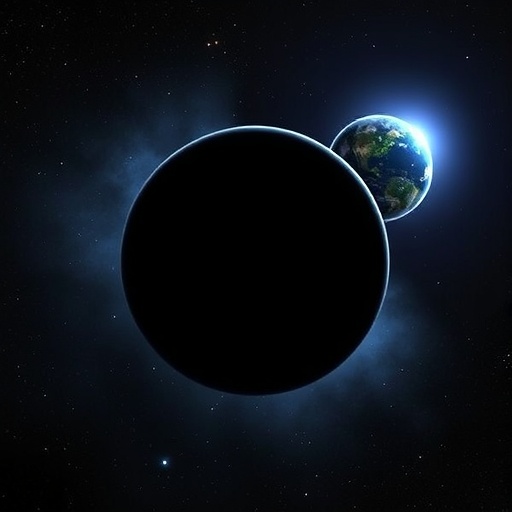An international consortium of astronomers has made a groundbreaking discovery in the field of planetary science, unveiling the existence of three Earth-sized planets in the binary star system TOI-2267. Situated approximately 190 light-years away from Earth, this discovery, detailed in a recent publication in the prestigious journal Astronomy & Astrophysics, significantly advances our understanding of planetary formation, especially in binary star systems. These environments, long considered inhospitable for complex planetary systems due to their dual gravitational influences, have now demonstrated their potential to host stable planetary bodies.
At the forefront of this exciting research is Sebastián Zúñiga-Fernández, a scientist involved with the ExoTIC group at the University of Liège. Zúñiga-Fernández highlights the exceptional arrangement of the planets within TOI-2267, where two planets transit one of the stars while a third planet transits its companion. This finding positions TOI-2267 as the first known binary system with transiting planets orbiting both stars, establishing a significant milestone in exoplanetary studies.
The nature of TOI-2267 as a compact binary system is critical to understanding its planetary dynamics. The two stars in this system orbit each other in close proximity, creating a gravitationally dynamic environment that challenges existing theories of planet formation. Researchers have identified three Earth-sized planets within tight orbits in this system, a revelation that contradicts traditional models which suggest such formations would be unlikely in binary configurations. Researchers Francisco J. Pozuelos, who contributed to this study, emphasizes that this system holds multiple records—it contains the closest and coldest stellar pair known to host planets, providing an unprecedented opportunity for research.
The multi-disciplinary nature of the investigation underscores the collaborative spirit of modern astronomical research. While NASA’s Transiting Exoplanet Survey Satellite (TESS) provided crucial observational data, the initial discovery of two of the planets was achieved using specialized software known as SHERLOCK, developed by a team of astronomers from the University of Liège and the Instituto de Astrofísica de Andalucía. This early detection allowed for prompt follow-up observations from ground-based telescopes, which were essential for confirming the nature of the planetary signals observed.
Confirmatory efforts included an intensive observational campaign involving several prominent astronomical facilities. Among these, the SPECULOOS and TRAPPIST telescopes played a pivotal role in characterizing the planets and solidifying the findings of the study. These robotic observatories are designed specifically to detect small exoplanets orbiting faint, cool stars, making them especially suited for this research endeavor. The successful integration of data from various instruments accentuates the benefits of combining the capabilities of space missions with specialized terrestrial observatories in the pursuit of exoplanetary knowledge.
Zúñiga-Fernández interprets the discovery of three Earth-sized planets in such a densely packed binary system as a remarkable opportunity for scientific advancement. It allows researchers to explore the limits of conventional planet formation models and stimulates further inquiry into the diversity of planetary architectures that may exist throughout the galaxy. Such an investigation can offer insights into processes that govern the emergence and sustenance of rocky planets under conditions previously assumed to be detrimental to their stability.
Pozuelos adds that TOI-2267 functions as a natural laboratory for understanding planetary evolution in complex dynamical environments. The configuration of this binary system raises critical questions regarding the viability and stability of planetary bodies formed under extreme conditions. As scientists continue to unravel the mechanisms governing these planetary systems, they are likely to enhance our theoretical frameworks and adapt our understanding of planetary formation processes considerably.
The implications of this discovery extend beyond theoretical discussions to practical applications in future astronomical observations. The unique characteristics of the TOI-2267 system can pave the way for in-depth investigations using upcoming advanced instruments like the James Webb Space Telescope and the next generation of large ground-based telescopes. These facilities are poised to make highly precise measurements of these planets, potentially revealing vital information regarding their masses, densities, and atmospheric compositions.
The combination of cutting-edge technology and collaborative efforts between space telescopes and ground-based observatories reflects the current trajectory of exoplanetary science. By leveraging the strengths of both arenas, researchers can significantly advance the field, pushing boundaries and enhancing the overall understanding of the cosmos. This discovery serves as a notable case study, illustrating how new findings in exoplanet research can yield valuable insights into fundamental questions about the nature of our universe.
Furthermore, the TOI-2267 discovery encourages the exploration of additional binary systems that may harbor Earth-like planets. As astronomers analyze data from existing telescopes, the prospect of finding more planets in similar configurations becomes increasingly plausible. Each new discovery enriches the tapestry of our galaxy and illuminates the myriad possibilities for life beyond Earth, prompting humankind to reconsider its place in the cosmic hierarchy.
In summary, the identification of three Earth-sized planets in the binary system TOI-2267 signals a paradigm shift within the field of exoplanet research. By challenging existing models of planetary stability and formation, this groundbreaking discovery opens new avenues for investigation, fundamentally altering our understanding of how planetary systems can develop and thrive in unusual circumstances. As researchers continue to unravel the mysteries of these distant worlds, the quest for knowledge about the universe will undoubtedly advance, inspiring future generations of astronomers and scientists.
Subject of Research:: Exoplanets in a Binary Stellar System
Article Title:: Two warm Earth-sized exoplanets and an Earth-sized candidate in the M5V-M6V binary system TOI-2267
News Publication Date:: 24-Oct-2025
Web References:: DOI link
References:: Astronomy and Astrophysics
Image Credits:: ©Mario Sucerquia (University of Grenoble Alpes)
Keywords
Exoplanets, Binary Systems, Astronomy, Planet Formation, TOI-2267, Earth-sized Planets, TESS, SPECULOOS, Ground-based Telescopes, James Webb Space Telescope.




